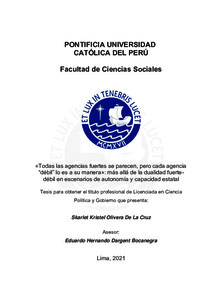| dc.contributor.advisor | Dargent Bocanegra, Eduardo Hernando | |
| dc.contributor.author | Olivera De La Cruz, Skarlet Kristel | |
| dc.date.accessioned | 2021-11-26T23:45:29Z | |
| dc.date.available | 2021-11-26T23:45:29Z | |
| dc.date.created | 2021 | |
| dc.date.issued | 2021-11-26 | |
| dc.identifier.uri | http://hdl.handle.net/20.500.12404/21012 | |
| dc.description.abstract | En un contexto marcado por desigualdad, débilidades estructurales y poca
presencia estatal, esta tesis busca conceptualizar una nueva tipología sobre
agencias estatales y sobre las trayectorias y movimientos que estas pueden
tener en el tiempo. Basándome en los conceptos de autonomía y capacidad
estatal, y en la propuesta de Bersch, Praca & Taylor (2017), sostengo que existen
escenarios que rompen con la dualidad fuerte-débil en agencias estatales. Ello
da pase a una discusión donde agencias que no son totalmente fuertes ni
totalmente débiles pueden ser halladas con mayor frecuencia en países de
ingreso medio como Perú. Identifico cuatro tipos de agencias de acuerdo a sus
niveles (altos o bajos) de autonomía y capacidad estatal. A las “Agencias
Fuertes” y “Agencias Débiles” se suman las “Agencias Ejecutoras” (baja
autonomía y alta capacidad) y las “Agencias Emancipadas” (alta autonomía y
baja capacidad). Para ilustrar aquello, a través de un diseño de investigación
mixto, presento los casos de la Comisión Nacional de Investigación y Desarrollo
Aeroespacial (CONIDA) y del Instituto Peruano de Energía Nuclear (IPEN), dos
instituciones científicas dedicadas a la investigación que han sobrevivido con el
tiempo. El argumento no solo se centra en explicar qué tipo de agencias son y
qué tipo de movimientos realizaron, sino también en responder a cuáles fueron
las razones detrás de dichos movimientos. Determinantes internos y externos
concentran buena parte de la explicación, que se acompaña de la voluntad que
tienen los políticos para destrabar e impulsar políticas públicas. Finalmente, esta
tesis deja lecciones no solo a nivel teórico, también a nivel práctico para las
interesadas e interesados en reformas de política. | es_ES |
| dc.description.abstract | In a context marked by inequality, structural weaknesses and minimal state
presence, this thesis seeks to conceptualize a new typology about state agencies
and their trajectories and movements over time. Based on the concepts of
autonomy and state capacity, and the proposal of Bersch, Praca & Taylor (2017),
I argue that there are scenarios that break with the strong-weak duality in the
state agencies. This leads to a discussion where agencies that are neither totally
strong nor totally weak can be found more frequently in middle income countries
like Peru. I identify four types of agencies according to their levels (high or low)
of autonomy and state capacity. "Executing Agencies" (low autonomy and high
capacity) and "Emancipated Agencies" (high autonomy and low capacity) are
added to the "Strong Agencies" and "Weak Agencies". To illustrate that, through
a mixed research design, I present the cases of the Comisión Nacional de
Investigación y Desarrollo Aeroespacial (CONIDA) and the Instituto Nacional de
Energía Nuclear (IPEN), two scientific institutions dedicated to research, which
have survived over time. The argument not only focuses on explaining what type
of agencies they are and what type of movements they had, but also on
answering what were the reasons behind said movements. Internal and external
determinants are a large part of the explanation, and they are accompanied by
the will that politicians have to expedite and promote public policies. Finally, this
thesis provides lessons not only at a theoretical level, but also at a practical level
for those interested in policy reforms. | es_ES |
| dc.language.iso | spa | es_ES |
| dc.publisher | Pontificia Universidad Católica del Perú | es_ES |
| dc.rights | info:eu-repo/semantics/openAccess | es_ES |
| dc.rights.uri | http://creativecommons.org/licenses/by/2.5/pe/ | * |
| dc.subject | Instituciones públicas--Aspectos políticos--Perú | es_ES |
| dc.subject | Sector público--Perú | es_ES |
| dc.subject | Administración pública--Perú | es_ES |
| dc.title | «Todas las agencias fuertes se parecen, pero cada agencia “débil” lo es a su manera»: más allá de la dualidad fuerte-débil en escenarios de autonomía y capacidad estatal | es_ES |
| dc.type | info:eu-repo/semantics/bachelorThesis | es_ES |
| thesis.degree.name | Licenciado en Ciencia Política y Gobierno | es_ES |
| thesis.degree.level | Título Profesional | es_ES |
| thesis.degree.grantor | Pontificia Universidad Catolica del Peru. Facultad de Ciencias Sociales | es_ES |
| thesis.degree.discipline | Ciencia Política y Gobierno | es_ES |
| renati.advisor.dni | 07885701 | |
| renati.advisor.orcid | https://orcid.org/0000-0002-1844-246X | es_ES |
| renati.author.dni | 72406056 | |
| renati.discipline | 312026 | es_ES |
| renati.juror | Rousseau, Stéphanie | es_ES |
| renati.juror | Tanaka Gondo, Ricardo Martín | es_ES |
| renati.juror | Dargent Bocanegra, Eduardo Hernando | es_ES |
| renati.level | https://purl.org/pe-repo/renati/level#tituloProfesional | es_ES |
| renati.type | https://purl.org/pe-repo/renati/type#tesis | es_ES |
| dc.publisher.country | PE | es_ES |
| dc.subject.ocde | https://purl.org/pe-repo/ocde/ford#5.06.00 | es_ES |






